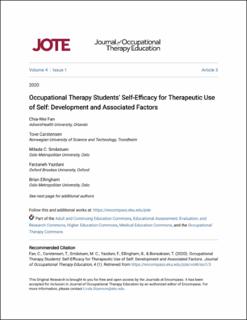| dc.contributor.author | Fan, Chia-Wei | |
| dc.contributor.author | Carstensen, Tove | |
| dc.contributor.author | Småstuen, Milada Cvancarova | |
| dc.contributor.author | Yazdani, Farzaneh | |
| dc.contributor.author | Ellingham, Brian | |
| dc.contributor.author | Bonsaksen, Tore | |
| dc.date.accessioned | 2020-12-14T08:01:45Z | |
| dc.date.available | 2020-12-14T08:01:45Z | |
| dc.date.created | 2019-09-22T21:42:03Z | |
| dc.date.issued | 2020 | |
| dc.identifier.citation | Journal of Occupational Therapy Education. 2020, 4 (1), 1-15. | en_US |
| dc.identifier.issn | 2573-1378 | |
| dc.identifier.uri | https://hdl.handle.net/11250/2718975 | |
| dc.description.abstract | Occupational therapy students need to develop self-efficacy for therapeutic use of self in practice. This longitudinal study examined Norwegian occupational therapy students’ self-efficacy for therapeutic use of self over a 16-month period and investigated predictors of their end-point self-efficacy. One hundred and eleven students from two universities completed a self-efficacy questionnaire related to the use of self after a workshop, and at 3-month, 10-month, and 16-month follow-up. The students’ self-efficacy development was analyzed with linear mixed effect models, while factors associated with self-efficacy were investigated with linear regressions. The students from both universities showed a linear increase in self-efficacy for therapeutic mode use (p < 0.001), recognizing clients’ interpersonal characteristics (p < 0.001), and managing interpersonal events (p < 0.001). However, for the students from University 1 the largest increase occurred in an early phase, whereas for the students from University 2 the largest increase occurred in a late phase. Only baseline scores were associated with the end-point measure at 16-month follow-up. The study indicates that students’ self-efficacy for therapeutic use of self increased during the follow-up period and adds to the knowledge about occupational therapy students’ self-efficacy development related to understanding and managing client-therapist interactions. | en_US |
| dc.language.iso | eng | en_US |
| dc.publisher | Eastern Kentucky University | en_US |
| dc.rights | Attribution-NonCommercial-NoDerivatives 4.0 Internasjonal | * |
| dc.rights.uri | http://creativecommons.org/licenses/by-nc-nd/4.0/deed.no | * |
| dc.title | Occupational therapy students’ self-efficacy for therapeutic use of self: Development and associated factors | en_US |
| dc.type | Peer reviewed | en_US |
| dc.type | Journal article | en_US |
| dc.description.version | publishedVersion | en_US |
| dc.source.pagenumber | 1-15 | en_US |
| dc.source.volume | 4 | en_US |
| dc.source.journal | Journal of Occupational Therapy Education | en_US |
| dc.source.issue | 1 | en_US |
| dc.identifier.doi | 10.26681/jote.2020.040103 | |
| dc.identifier.cristin | 1727579 | |
| dc.description.localcode | This work is licensed under a Creative Commons Attribution-Noncommercial-No Derivative Works 4.0 License. DOI: 10.26681/jote.2020.040103 | en_US |
| cristin.ispublished | false | |
| cristin.fulltext | original | |
| cristin.fulltext | original | |
| cristin.qualitycode | 1 | |

